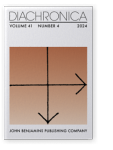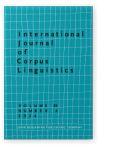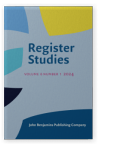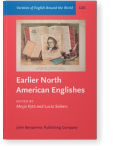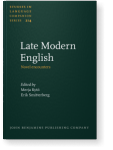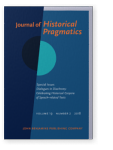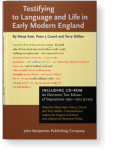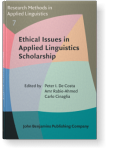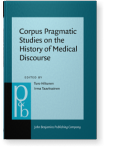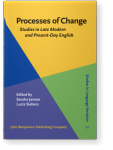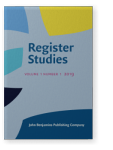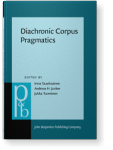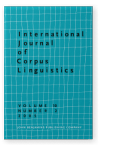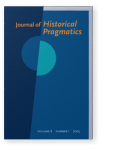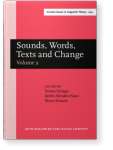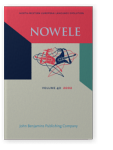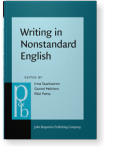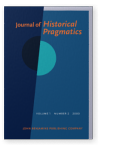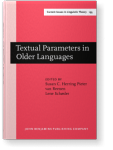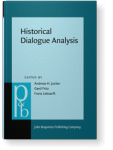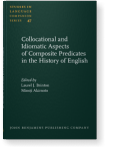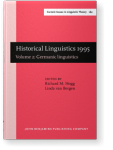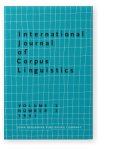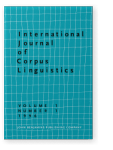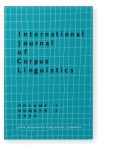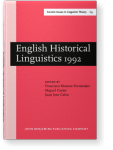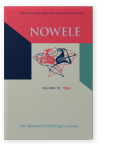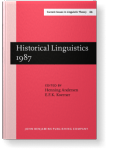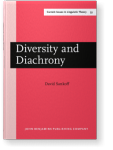Merja Kytö
List of John Benjamins publications for which Merja Kytö plays a role.
Journals
ISSN 1384-6655 | E-ISSN 1569-9811
Earlier North American Englishes
Edited by Merja Kytö and Lucia Siebers
[Varieties of English Around the World, G66] 2022. viii, 261 pp.
Subjects English linguistics | Germanic linguistics | Historical linguistics | Sociolinguistics and Dialectology
Late Modern English: Novel encounters
Edited by Merja Kytö and Erik Smitterberg
[Studies in Language Companion Series, 214] 2020. vii, 359 pp.
Subjects English linguistics | Germanic linguistics | Historical linguistics
Dialogues in Diachrony: Celebrating Historical Corpora of Speech-related Texts
Edited by Merja Kytö and Terry Walker
Special issue of Journal of Historical Pragmatics 19:2 (2018) v, 141 pp.
Subjects Discourse studies | Historical linguistics | Pragmatics
Testifying to Language and Life in Early Modern England: Including a CD-ROM containing An Electronic Text Edition of Depositions 1560–1760 (ETED)
Merja Kytö, Peter J. Grund and Terry Walker
[Not in series, 162] 2011. xxi, 360 pp. (Incl. CD-Rom)
Subjects Corpus linguistics | Discourse studies | Electronic/Multimedia Products | English linguistics | Forensic & legal linguistics | Historical linguistics | Pragmatics
2024 Chapter 1. A taxonomy of questionable research practices in quantitative humanities Ethical Issues in Applied Linguistics Scholarship, De Costa, Peter I., Amr Rabie-Ahmed and Carlo Cinaglia (eds.), pp. 10–27 | Chapter
A growing body of research has begun to address ethical issues in the context of Applied Linguistics (e.g., De Costa, 2016; Isbell et al., 2022). One of the messages inherent in this line of inquiry is that ethical concerns are embedded throughout the research cycle from study conceptualization… read more
2022 Coordination in the courtroom: The uses of and in the records of the Salem witchcraft trials Earlier North American Englishes, Kytö, Merja and Lucia Siebers (eds.), pp. 37–64 | Chapter
Previous research has shown that clausal and phrasal uses of and pattern in ways characteristic of different text types in both Present-day and early English. Speech-based text types such as witness depositions and trial records are likely to show higher rates of clausal uses than written-based… read more
2022 Earlier North American Englishes: Recent advances and future prospects Earlier North American Englishes, Kytö, Merja and Lucia Siebers (eds.), pp. 1–18 | Chapter
2022 Chapter 5. Survival or death: M ine/my and thine/thy variation in Early Modern English medical writing Corpus Pragmatic Studies on the History of Medical Discourse, Hiltunen, Turo and Irma Taavitsainen (eds.), pp. 105–126 | Chapter
This quantitative and qualitative study examines the chronological development of the possessive determiners mine, my, thine, and thy in the Early Modern English Medical Texts corpus (EMEMT), focusing on the influence of phonological environment and text category, as well as noting lexical items… read more
2020 Introduction: Late Modern English studies into the twenty-first century Late Modern English: Novel encounters, Kytö, Merja and Erik Smitterberg (eds.), pp. 1–17 | Chapter
2019 Chapter 4. A (great) deal of: Developments in 19th-century British and Australian English Processes of Change: Studies in Late Modern and Present-Day English, Jansen, Sandra and Lucia Siebers (eds.), pp. 49–72 | Chapter
All variants of the form a x deal of are investigated across nineteenth-century English in south-eastern England and in Australia. Determiner uses dominate followed by adverbial uses with verbs and pronominal uses coming last. The great majority of items found include an adjective, almost… read more
2019 Register in historical linguistics Register Studies 1:1, pp. 136–167 | Article
Merja Kytö is Professor of English Language at Uppsala University. In this article, she provides a detailed accounting of the role of register in research on the historical development of language. Her substantial body of work has focused on both the historical development of specific registers,… read more
2018 Introduction Dialogues in Diachrony: Celebrating Historical Corpora of Speech-related Texts, Kytö, Merja and Terry Walker (eds.), pp. 161–166 | Introduction
2014 I had lost sight of them then for a bit, but I went on pretty fast: Two degree modifiers in the Old Bailey Corpus Diachronic Corpus Pragmatics, Taavitsainen, Irma, Andreas H. Jucker and Jukka Tuominen (eds.), pp. 29–52 | Article
This article investigates the degree modifiers pretty and a bit in the subsection 1730s–1830s of the Old Bailey Corpus (OBC), containing speech-based/related data (ca. 50 million words). Pretty is shown to be already grammaticalized, with the degree modifier uses clearly dominating.… read more
2011 8. ETED: Distribution versions, editorial principles, and viewing and search options Testifying to Language and Life in Early Modern England: Including a CD-ROM containing An Electronic Text Edition of Depositions 1560–1760 (ETED), Kytö, Merja, Peter J. Grund and Terry Walker, pp. 247–282 | Chapter
2011 1. Introduction Testifying to Language and Life in Early Modern England: Including a CD-ROM containing An Electronic Text Edition of Depositions 1560–1760 (ETED), Kytö, Merja, Peter J. Grund and Terry Walker, pp. 1–14 | Chapter
2011 9. Conclusion Testifying to Language and Life in Early Modern England: Including a CD-ROM containing An Electronic Text Edition of Depositions 1560–1760 (ETED), Kytö, Merja, Peter J. Grund and Terry Walker, pp. 283–287 | Chapter
2011 7. Linguistic variation and change in the depositions Testifying to Language and Life in Early Modern England: Including a CD-ROM containing An Electronic Text Edition of Depositions 1560–1760 (ETED), Kytö, Merja, Peter J. Grund and Terry Walker, pp. 215–246 | Chapter
2010 Non-standard language in earlier English Varieties of English in Writing: The written word as linguistic evidence, Hickey, Raymond (ed.), pp. 15–42 | Article
The concept of ‘non-standard’ remains somewhat fuzzy during the Early Modern English period. Language change and especially ongoing standardization can make it difficult to pin down an individual feature at any given time as clearly non-standard. Contemporary views of ‘good’ language, which we also… read more
2005 “We had like to have been killed by thunder & lightning”: The semantic and pragmatic history of a construction that like to disappeared Journal of Historical Pragmatics 6:1, pp. 1–35 | Article
This article discusses the semantic and pragmatic history of a grammatical construction consisting of a form of Be/Have + like followed by an infinitival verb form, which became obsolete in Standard English in the nineteenth century, but still survives in some regional varieties of British and… read more
2002 Lexical bundles in Early Modern English dialogues: A window into the speech-related language of the past Sounds, Words, Texts and Change: Selected papers from 11 ICEHL, Santiago de Compostela, 7–11 September 2000, Fanego, Teresa, Belén Méndez-Naya and Elena Seoane (eds.), pp. 45–63 | Article
2002 The go-Futures in English and French Viewed as an Areal Feature NOWELE Volume 40 (April 2002), pp. 29–60 | Article
2000 “Pills to Purge Melancholy” — Nonstandard Elements in A Dialogue Against the Feuer Pestilence Writing in Nonstandard English, Taavitsainen, Irma, Gunnel Melchers and Päivi Pahta (eds.), pp. 151–170 | Article
2000 Data in historical pragmatics: Spoken interaction (re)cast as writing Journal of Historical Pragmatics 1:2, pp. 175–199 | Article
In this paper we examine four speech-related text types in terms of how linguistically close they are to spoken face-to-face interaction. Our “conversational” diagnostics include lexical repetitions, question marks (as an indicator of question-answer adjacency pairs), interruptions, and… read more
2000 Robert Keaynes Notebooks: A verbatim record of spoken English in early
Boston? Textual Parameters in Older Languages, Herring, Susan C., Pieter van Reenen and Lene Schøsler (eds.), pp. 273–308 | Article
1999 Modifying Pragmatic Force: Hedges in Early Modern English Dialogues Historical Dialogue Analysis, Jucker, Andreas H., Gerd Fritz and Franz Lebsanft (eds.), pp. 293–312 | Article
1999 Chapter 6: Collocational and Idiomatic Aspects of Verbs in Early Modern English Collocational and Idiomatic Aspects of Composite Predicates in the History of English, Brinton, Laurel J. and Minoji Akimoto (eds.), pp. 167–206 | Chapter
1998 Backdating the English Constraint Grammar Parser for the analysis of English historical texts Historical Linguistics 1995: Volume 2: Germanic linguistics, Hogg, Richard M. and Linda van Bergen (eds.), pp. 149–166 | Article
1997 Abstracts International Journal of Corpus Linguistics 2:2, pp. 309–313 | Section header
1997 Abstracts International Journal of Corpus Linguistics 2:1, pp. 173–179 | Miscellaneous
1996 Abstracts International Journal of Corpus Linguistics 1:1, pp. 155–170 | Miscellaneous
1996 Abstracts International Journal of Corpus Linguistics 1:2, pp. 335–343 | Miscellaneous
1994 Be vs. Have with Intransitives in Early Modern English English Historical Linguistics 1992: Papers from the 7th International Conference on English Historical Linguistics, Valencia, 22–26 September 1992, Fernández, Francisco, Miguel Fuster Márquez and Juan Jose Calvo (eds.), pp. 179–190 | Article
1990 Shall or will ? Choice of the variant form in Early Modern English, British and American Historical Linguistics 1987: Papers from the 8th International Conference on Historical Linguistics, Lille, August 30-September 4, 1987, Andersen, Henning and E.F.K. Koerner † (eds.), pp. 275–288 | Article
1986 On the use of the modal auxiliaries Can and May in American English Diversity and Diachrony, Sankoff, David, pp. 123–138 | Article
